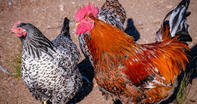Identifying the sex of a baby chick is difficult, because unlike most other animals the sexual organs of chicken are located within their bodies and not easily distinguishable.

There are a few fallacies, for example, that the sex of a chick can be determined by rotating a needle on a string over its head.
The chick is then believed to be male if the weight rotates clockwise and female if it rotates anti-clockwise. Or, if you hold a chick by the scruff of its neck and it lifts it legs it’s a girl, but if its legs hang lose, it is a boy.
Another fallacy is that sex can be determined by looking at the shape of an egg, the idea being that football shaped eggs house boy chicks, while oval or round shaped eggs house girl chicks. These methods are as accurate as flipping a coin to determine the gender of a bird, with your chances of identifying the sex correctly being slightly higher if you are an inherently lucky person.
The most accurate ways of determining the gender of birds is through feather sexing, vent sexing and by waiting and seeing. Other methods are also being developed that allows for gender identification in the eggs already, but most of these are still very expensive and require highly specialised procedures.
Feather Sexing

In some hybrids and breeds the females show faster feathering traits than the males. The girls may have well developed wing feathers, whereas the boys may be completely bald.
Generally, the length of the plume feathers on the wings are compared to differentiate between the two sexes. This however only works with newly hatched chicks, as the difference will disappear after two weeks.
The colours of some breeds or hybrids may also be indicative of the sex of the birds. Mating barred hens (with black and white striped feathers) with males that are not striped, will result in barred males and non-barred female chicks.
The same can be done with silver and gold colour patterns, with silver males and golden females producing white creamy or slate coloured pullets and buff or reddish coloured cockerels. Golden males on silver females, on the other hand will produce golden pullets and silver cockerels.
Vent Sexing
Vent sexing was developed by Professor Kiyoshi Masui in Japan in the 1930s. It is a highly specialised procedure that entails the visual examination of the vent of the bird for the presence or absence of a sex organ that basically looks like a bump. There are apparently over fifteen different shapes to consider.
Professional sexers are able to sex chicks in a matter of seconds with a accuracy level of 90% to 95%, where as the accuracy levels or trained non-professionals are usually below 70%. Amateurs should definitely not attempt it, as doing it wrong can result in the disembowelment and death of chicks.
Wait and See

- Start acting more manly and attempt to crow
- Their feathers will change from the round oval shaped feathers common to hens and young birds, to shiny more narrow and pointed feathers found on their necks and at the base of their tails
- Their combs and wattles will develop earlier and become larger than those of females
- The heads will become more angular and masculine looking
- Certain breeds also have a characteristic colour pattern that helps to identify them